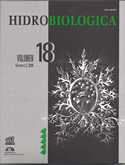Variación espacial de la biomasa de macroalgas en una zona de transición templado-tropical en la Península de Baja California, México
Keywords:
Biomass, Transition zone, Gelidium, Macrocystis, physiographic.Abstract
Biomass changes of seaweed assemblages in four locations in a temperate-tropical transition zone were analyzed between October 1996 and August 1997. Locations with lower temperature, a high index of upwelling, and high quantities of hard substrate presented the largest values of biomass of seaweed (El Cardoncito (7.2 kg m-2), and Las Boyitas (6.2 kg m-2)) and the biggest quantity of species of temperate affinity. Conversely, El Datilito (0.366 kg m-2), with a higher temperature, no evidence of upwelling, sandy substrate, and located in protected shallow waters, presented the lowest values of biomass and the lowest proportion of temperate affinity seaweed. The PCA and similarity analysis showed a close relationship between El Cardoncito and Las Boyitas. El Datilito was categorized as independent location, while Chester Rock (4.3 kg m-2) displayed intermediate characteristics. The close relationship observed between the first two locations can be explained by the similarity of their high biomass and physiographic and environmental characteristics. El Datilito has very different physiographic and environmental characteristics and a very low biomass.Downloads
Downloads
Published
How to Cite
Issue
Section
License
Los autores/as que publiquen en esta revista aceptan las siguientes condiciones:
De acuerdo con la legislación de derechos de autor, HIDROBIOLÓGICA reconoce y respeta el derecho moral de los autores, así como la titularidad del derecho patrimonial, el cual será cedido a la revista para su difusión en acceso abierto.
Publicar en la revista HIDROBIOLÓGICA tiene un costo de recuperación de $500 pesos mexicanos por página en blanco y negro (aproximadamente 29 dólares americanos) y $1000 pesos por página a color (aproximadamente 58 dólares americanos).
Todos los textos publicados por HIDROBIOLÓGICA sin excepción se distribuyen amparados bajo la licencia Creative Commons 4.0Atribución-No Comercial (CC BY-NC 4.0 Internacional), que permite a terceros utilizar lo publicado siempre que mencionen la autoría del trabajo y a la primera publicación en esta revista.
Los autores/as pueden realizar otros acuerdos contractuales independientes y adicionales para la distribución no exclusiva de la versión del artículo publicado en HIDROBIOLÓGICA (por ejemplo incluirlo en un repositorio institucional o publicarlo en un libro) siempre que indiquen claramente que el trabajo se publicó por primera vez en HIDROBIOLÓGICA.
Para todo lo anterior, el o los autor(es) deben remitir el formato de Carta-Cesión de la Propiedad de los Derechos de la primera publicación debidamente requisitado y firmado por el autor(es). Este formato se puede enviar por correo electrónico en archivo pdf al correo: enlacerebvistahidrobiológica@gmail.com; rehb@xanum.uam.mx (Carta-Cesión de Propiedad de Derechos de Autor).
Esta obra está bajo una licencia de Creative Commons Reconocimiento-No Comercial 4.0 Internacional.


